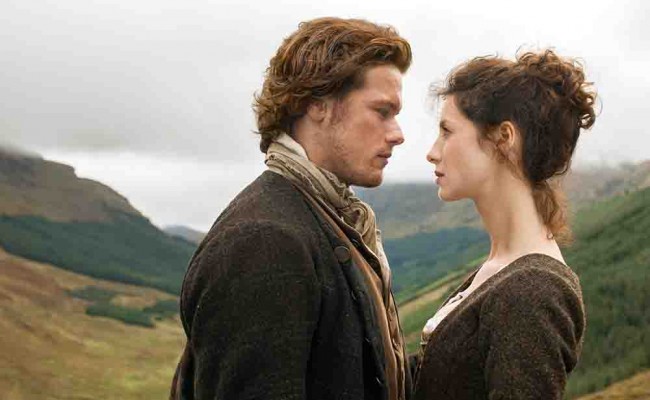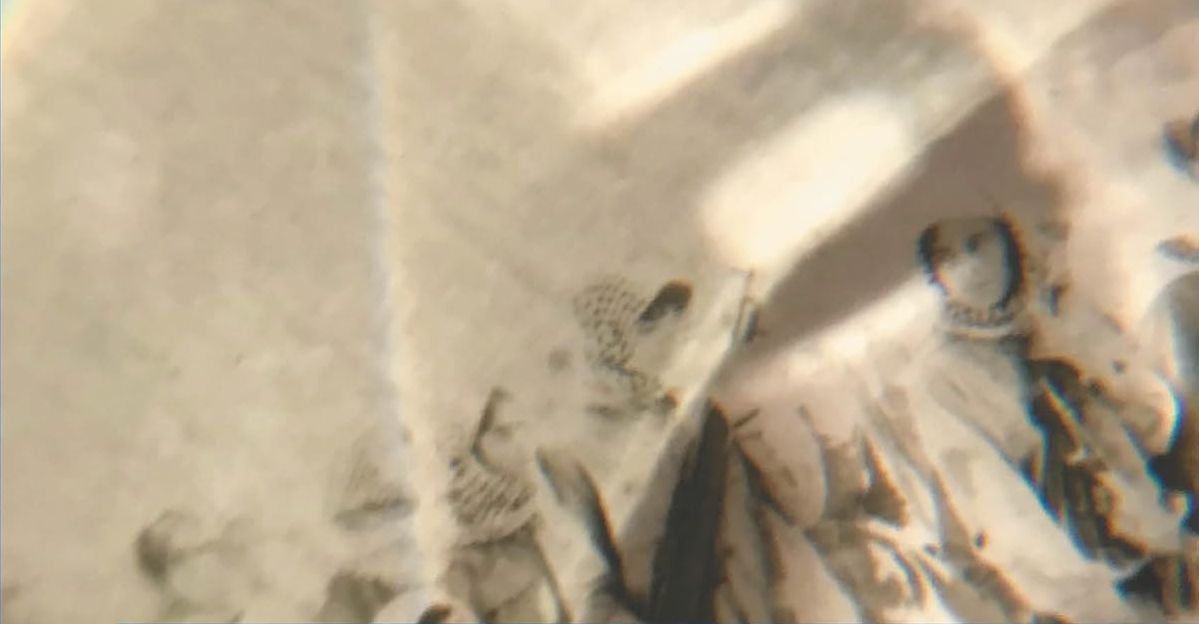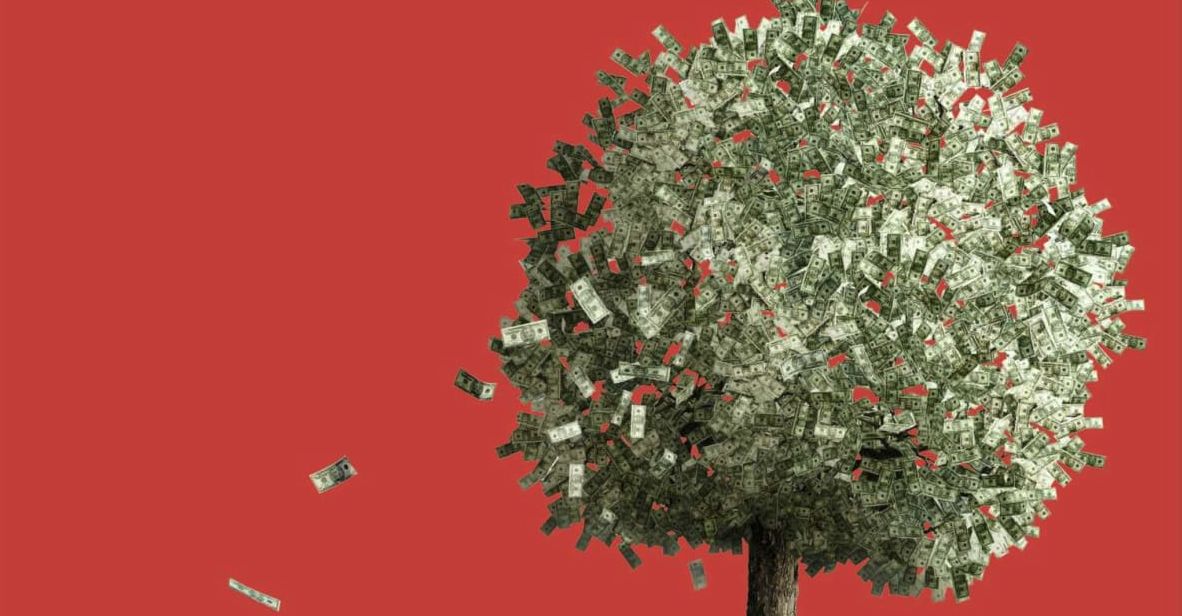Take off your shirt. I want to look at you.
These words, spoken in ‘The Wedding’, the seventh episode of Outlander, are radical, because they are spoken by a woman to a man. Unlike Game of Thrones, the show to which it is most frequently compared, Outlander is governed exclusively by an active, desiring female gaze.
In her famous 1973 essay ‘Visual Pleasure and Narrative Cinema’, Laura Mulvey argues that on the screen, women are regularly represented as ‘the image’ while men are the ‘bearer of the look’: that is, men look, while women are looked at. She contends that this gaze exists at three levels – the gaze of the characters, the gaze of the camera, and the gaze of the audience – and that all three levels are dominated by heterosexual men.
This is not the case in Outlander. The dominant gaze within the show is that of heroine Claire (Caitriona Balfe), a married English war nurse from 1945 who finds herself swept back in time to 1743 Scotland. The series is adapted by from a 1991 first person novel by Diana Gabaldon, and, unlike in other first person novel-to-screen adaptations, such as True Blood, this first person conceit is largely maintained. Claire’s experiences are the centre of the narrative. It is through her female eyes that we view the story and the world around her.
As well as having female-authored source material, many episodes are both written and directed by women (for example, ‘The Wedding’ was written by Anne Kenney and directed by Anna Foerster). Claire’s gaze and the gaze of the camera combine to imply a heterosexual female viewer. It is not just Claire that wants to look at the show’s hero Jamie (Sam Heughan) when she orders him to take off his shirt. It is also this implied viewer.
While author Gabaldon frequently denies that her Outlander series are romance novels (‘my books don’t fit the standard conventions of the modern romance at all,’ she writes in the FAQ section of her website) the first book won the 1991 RITA award for Best Historical Romance and regularly features in the top ten of the annual All About Romance poll of readers’ top hundred romances. If Gabaldon’s books perhaps do not fit some of the romance’s generic requirements, the centrality of Claire and Jamie’s relationship and the romantic tropes mobilised mean that they are certainly situated in a romantic space – something which is key, I contend, to the female gaze that has been translated onto the screen.
Popular romance fiction is rarely thought of as a radical space, but it is a genre (perhaps the only genre) that is consistently governed by an active, desiring female gaze. Modern romance novels are written almost entirely by women for women, and female experiences – particularly female desire and pleasure – are among romance’s most prevalent concerns. As Jayne Ann Krentz writes in the introduction to Dangerous Men and Adventurous Women, romance novels ‘defy the masculine conventions of other forms of literature because they portray women as heroes.’ Even if Outlander is not exactly a romance, it is follows many of the genre’s tropes and traditions.
The popularity of Game of Thrones has led to a growing practice of treating fantasy texts as worthy of cultural criticism in mainstream discourse, but Outlander has not caused the same to happen for romance: indeed, the idea that Outlander is a ‘bodice ripper’ is frequently disavowed. Nonetheless, Outlander’s desiring female gaze is one regularly represented in popular romance: a generic space dominated by female authors and readers that not only takes female perspectives, desires, and pleasures seriously, but is governed by and celebrates them.
Consent and the erotics of talk
In ‘The Wedding’, Claire is compelled to marry young highlander Jamie. It is not a marriage she wants or chooses. This would seem to set the scene for a similarly coerced consummation, especially when we consider that their wedding takes place in 1743: by becoming Jamie’s wife, Claire becomes his property under the laws of the time.
This ‘forced marriage’ trope is relatively common in historical romance, and the rape of the heroine by the hero (marital or otherwise) was a regular feature in the early historical romances of the 1970s and 1980s. However, more recent popular romance has moved away from this tradition towards a model which places emphasis on the heroine’s enthusiastic consent and sexual participation, even where marriage has been compelled. Jamie and Claire’s relationship follows this more modern model: ‘You needn’t be afraid of me, Claire – I wasnae about to force myself on ye,’ Jamie tells a visibly nervous Claire in ‘The Wedding’.
‘I never thought you would,’ is her reply.
Jamie and Claire’s relationship is characterised by communication and conversation. Long before their marriage, there are frequent scenes of them talking and laughing together: they are friends who genuinely like and have a mutual respect for each other. Feminist scholar Carla Kaplan has outlined a concept she calls the ‘erotics of talk’ in women’s writing. She argues that in these texts, women are often seeking an ideal listener: someone who will listen to them, respect them, and take their experiences seriously. This erotics of talk (which is frequently evident in popular romance fiction) is the primary paradigm that governs Claire and Jamie’s relationship: they like to talk and listen to each other.
This engenders a relationship which is radically egalitarian, given the power dynamics inherent not only in the heterosexual relationships of the eighteenth century but also those we frequently see on screen. Jamie does not want to just look at or sleep with Claire: he wants to know her, to talk to her, to listen to her, to understand her. He is anxious to know whether she enjoys sex – ‘did you like it?’ he asks Claire immediately following their first sexual encounter. In their second encounter, she has a vocal orgasm and he stops immediately, worried that he has hurt her, but is delighted when she explains to him what has happened. (‘I didnae know a woman could…’ he says, something which signifies not only the absence of female pleasure in his eighteenth century Scottish culture, but in filmic sexual scripts more broadly.)
Similarly, the trust and communicative bond between Jamie and Claire means that she does not need to be afraid of expressing her desire. She initiates all three of their sexual encounters in ‘The Wedding’. When she orders Jamie to take off his shirt because she wants to look at him, and later, when she bites and kisses her way down his naked body, she is not afraid he will slut-shame her in the morning: something deeply pleasurable for an implied female viewer.
Sexual violence
Many pieces have been published lauding Outlander’s portrayal of female sexual desire and pleasure, particularly in ‘The Wedding’. However, this has obscured attention from the other facet of sex within the show: sexual violence.
The threat of sexual violence is a constant hum in the background of Outlander. Claire is threatened with rape several times: indeed, the first thing that happens to her upon arrival in 1743 is an attempted rape by the show’s villain, sadistic English officer Black Jack Randall (Tobias Menzies). In the mid-season finale ‘Both Sides Now’, one of Jamie and Claire’s trysts is interrupted by two English deserters, one of whom attempts to overpower and rape Claire, though she escapes by stabbing him in the kidneys. This episode of violence is in stark contrast to the laughing, communicative, pleasurable sex that Claire and Jamie had been having only moments before (indeed, their mid-coital conversation drowned out the noise of the approaching danger).
Outlander is not gratuitous in its representation of sexual violence. It maintains a resolutely female perspective: in ‘Both Sides Now’, more screen time is devoted to Claire’s reaction to her attempted rape (she goes into shock) than the incident itself. It is also heartening to see Claire push back against the rape culture of the period. When she relates the story of her attempted rape at the hands of Black Jack to the laird Colum MacKenzie, the following piece of dialogue occurs:
COLUM: You’re saying that a man bearing the King’s Commission decided to rape a stray lady traveller he came upon in the woods for no good reason?
CLAIRE: Is there ever a good reason for rape, Master MacKenzie?
The subversiveness of this kind of moment on the screen cannot be underestimated: the semantic possibility that there might be a good reason for rape is rebutted by the show as Claire forces a man – a powerful man, in this case – to see things from a female perspective. However, the constant threat of sexual violence is wearisome for the show’s female viewers. While the depiction of rape is accurate – and provides further evident of the show’s female gaze – it is still exhausting.
It is for this reason that I suspect ‘The Wedding’, which focuses solely on Jamie and Claire’s marriage and wedding night, will be Outlander’s most beloved episode for many female viewers. Despite the coerced circumstances of their marriage, Jamie does not pose a sexual threat to Claire. Their communicative, caring and mutually participatory sex life, governed by a romantic erotics of talk, is a welcome contrast to both common male gaze-driven scenes elsewhere and to the scenes of sexual violence within the show, where male aggressors attempt to treat the female body as an object to overpower and use. In ‘The Wedding,’ without the threat of sexual violence, the female viewer can be content simply to take pleasure in looking.






